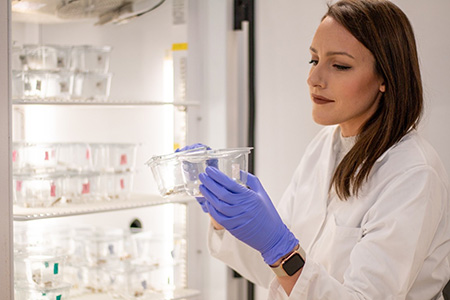
Insect Meal: A Grand Challenge
 |
Ann Donoghue is the Research Leader at the Poultry Production and Product Safety Research Unit in Fayetteville, AR. She is one of nearly 50 ARS scientists currently working on the MINIstock (Model for INsect Inclusion) Grand Challenge for Sustainable Agriculture (MINIstock is a play on the term “mini livestock”). |
Welcome to Under the Microscope, Dr. Donoghue.
UM: What is insect meal, and why is ARS running a Grand Challenge to research it?
AD: Insect meal is a protein-rich ingredient made from processed (e.g., dried, ground, and sometimes defatted) insects, typically black soldier fly larvae, mealworm larvae, or crickets that have been mass-reared in highly controlled, industrial environments.
Sustainable protein production and reducing food loss and waste are key agricultural issues, and the mass-reared insect industry has the potential to tackle both. Insects are highly nutritious and comprise the natural diet of many agricultural animals (e.g., fish and chickens). They can also be reared year-round indoors and are highly amenable to vertical agriculture. This makes them an accessible and dependable source of nutrients and revenue worldwide. They are incredibly sustainable to produce, because they are natural nutrient recyclers and will happily feed on food or agricultural waste that would otherwise be unfit for consumption. Moreover, the waste from insect production, known as frass, is a sustainable natural fertilizer in crop production. In this way, insects fill a unique role in upcycling food waste into value-add products, making them an integral player in a circular agricultural economy.
UM: Is insect meal being used now?
AD: Yes, insect meal is currently being used as animal and pet feed, human food (e.g., as protein powder and in energy bars, snacks, and desserts), and other insect-based products (e.g. fertilizer). Their nutritional value (rich in protein, essential amino acids, fats, vitamins and minerals), sustainability advantages, and ability to supplement unsustainable protein sources make insects an excellent dietary component, and will drive their increased use in the near future.
UM: Are there certain insects that are particularly well-suited to being used as meal?
AD: Over 2,000 insect species have been identified as edible worldwide. There are three main groups of insects used commercially: yellow mealworms, black soldier flies, and crickets. These insects are used because of their high efficiency of production (intrinsic rate of increase, biomass increase/day, and feed conversion) and an ability to live in high-density conditions while being relatively resistant to infectious diseases.
UM: Are there other ways that farmed insects might be used, in addition to serving as feed?
AD: Absolutely. While insect meal is known to be a nutrient-rich feed source, quantifying the value that it provides gives the insect industry additional data to compete in the alternative feed source market. For example, multiple studies have indicated that insect meal may act as a prebiotic in the chicken intestinal tract to improve their immune defense, potentially protecting against disease. Researchers within MINIstock are working to conclusively identify the impact of yellow mealworm larvae meal on the immune-related health of broiler chickens.
Insect waste, known as frass, can be used as an organic fertilizer source, which further increases the sustainability of insect production. Insect frass can increase nutrient content in soils and uptake by crops, enhance soil microbial activity, plant resistance to stress, and biomass production compared to synthetic fertilizers and other organic fertilizers. It could serve as an emerging organic soil amendment for improving soil health, carbon sequestration, and sustainably intensify cropping systems. And value-add products continue to emerge. For example, recent discoveries that black soldier fly larvae contain high amounts of linoleic acid (an ingredient commonly found in cosmetics and pharmaceuticals) mean that they could potentially serve as a sustainable alternative to current sources.
 Research entomologist Kristin Duffield monitors disease in reared crickets. Her work aims to provide critical foundational research for monitoring, identifying, and treating the diseases impacting the health and yield of reared insects. (Photo by José Ramirez, ARS).
Research entomologist Kristin Duffield monitors disease in reared crickets. Her work aims to provide critical foundational research for monitoring, identifying, and treating the diseases impacting the health and yield of reared insects. (Photo by José Ramirez, ARS).
UM: How are insects raised in captivity?
AD: This largely depends on the species, as well as the scale of the rearing operations. Excitingly, many larger producers are integrating modern technology capabilities through robotics and artificial intelligence (AI) with the goal of increasing automation and reducing the amount of human labor needed for production. Innovation is clearly at the forefront of this industry and will be essential for ensuring this sustainable protein source is a cost-effective option.
UM: Are there any challenges posed by the conditions of captive insect rearing that research can help to address?
AD: Absolutely. MINIstock’s research is focused around 7 working groups targeting specific challenges within the industry: 1) optimizing insect feeding and rearing, 2) identifying and tackling insect diseases, 3) optimizing waste upcycling, 4) ensuring food and feed safety, 5) harvesting wild insects, 6) utilizing frass, and 7) incorporation into aquaculture. Our MINIstock scientists are leading efforts in research on the epidemiology of diseases affecting mass-reared insects with the goal of providing solutions to prevent, detect, manage, and treat the diseases that can have devastating impacts on production.
UM: How is the Grand Challenge approaching the issue of insect genetic development?
AD: One of our primary goals is to provide the genetic resources and foundational descriptive research for the top reared species. This information is critical for informing and improving breeding practices so the industry can raise insects that are healthier, more resistant to diseases, grow faster, produce more eggs, are more efficient at upcycling specific waste inputs, and/or require fewer resource inputs (e.g., food and water).
UM: How does this initiative relate to the idea of a circular economy and sustainability?
AD: Insects stand apart from other alternative protein sources because of their ability to upcycle common low-value waste streams (e.g., food, agricultural, and municipal waste), including manure and plastics. Use of low value waste sources as insect diet can not only decrease input costs but also makes them an integral player in a circular economy where they function to transform waste into high-quality protein and other value-add products.
UM: What are the team’s long-term goals and hopes for this Grand Challenge?
AD: Venture capital funding to insect farming is currently estimated at over $400 million globally. As there are critical research needs for this emerging agricultural commodity, MINIstock ARS scientists are focused on supporting farmers in the U.S. as they stand up this high-impact commodity. We aim to develop a model of insect production through sound research that will provide the insect production industry with solutions, and accelerate the adoption of insect products into animal diets.
Contributors to the answers above include the following: Kelsy Robinson, research biologist, ARS Poultry Research Unit, Mississippi State, MS and Co-Lead of the MINIstock Grand Challenge; Kristin Duffield, post-doctoral researcher with the ARS Crop Bioprotection Unit in Peoria, IL and the Geospatial and Environmental Epidemiology Research Unit, Mississippi State, MS; Komala Arsi, post-doctoral researcher in the Poultry Production and Product Safety Research Unit, Fayetteville, AR; Martha Marie Vaughan, Research Leader of the Mycotoxin Prevention and Applied Microbiology Research Unit, Peoria IL; and Kim Cook, National Program Leader, Office of National Programs and MINIstock Grand Challenge Facilitator.
You May Also Like:
